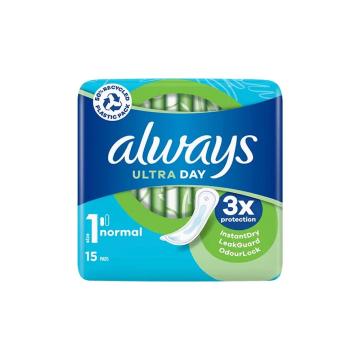
Don’t settle for less than 3x protection with Always Ultra Day Pads 1 Normal 15s. Always pads absorb in seconds thanks to their InstantDry technology, and they prevent leaks & odours thanks to their LeakGuard and OdourLock technologies. For extra protection at night, try Always Ultra Size 4. Always pads are dermatologically approved by the Skin Health Alliance.
Product Features
- 3x Protection so that you can feel fresh and clean during your period
- Super absorbent sanitary towel with InstantDry system that absorbs liquid in seconds
- LeakGuard technology locks liquid and helps to prevent leaks
- Always Ultra Sanitary Towels come with Odourlock technology which neutralises odours
- Approved by dermatologists of Skin Health Alliance
Your Menstrual Cycle Phases
The Menstrual Phase (Menstruation)
The menstrual phase is the part commonly referred to as “your period.” The official start of your cycle is the first day of your menstrual phase – the first day of your period. You may be thinking, “Where is this stuff coming from?” Menstrual blood is shed from the lining of your uterus. It goes from your uterus through your cervix, vagina and out through your vaginal opening. A period usually lasts about three to seven days. It may seem like more, but the average amount of menstrual flow for your entire period is about a quarter of a cup!
The Follicular Phase
This phase is all about your body preparing for pregnancy each month. It starts with your estrogen hormone telling the lining of your uterus to thicken and develop to prepare for a fertilized egg. At the same time, another hormone, known as the follicle-stimulating hormone (FSH), stimulates your ovarian follicles to grow. Each follicle contains an egg. Usually, one egg will get totally ready for fertilization each month. Your estrogen levels rise dramatically during the days before ovulation and peak about one day before the next phase starts. If you have regular 28-day menstrual cycles, ovulation usually occurs on day 14.
The Ovulation Phase
This surge in estrogen triggers a spike in a third hormone – the luteinizing hormone, or LH. LH is what makes a follicle rupture and release an egg. If you have regular 28-day menstrual cycles, ovulation usually occurs on day 14. However, most women have different menstrual cycle lengths. In general, ovulation happens 11 to 16 days before your upcoming period. Ovulation is what it’s called when one of the ovaries releases a mature egg. The egg travels out of the ovary, into the nearest fallopian tube and into your uterus. As the egg moves down the fallopian tube over several days, the lining of the uterus continues to grow thicker and thicker. It takes about three to four days for the egg to travel toward the uterus. From there, an egg waits for about 24 hours in hopes of being fertilized before it starts degenerating.
The Luteal Phase
After ovulation, the luteal phase begins. The empty follicle turns into a corpus luteum. The cells of the corpus luteum produce estrogen and large amounts of progesterone. Progesterone stimulates your uterine lining to prepare for a fertilized egg.
-
Storage Information
Do not store above 25cDo not store above 25c, away from direct sources of heat and humidity. Keep in original container
